|
SNORKELING
in the
EMIRATES
by Marijcke Jongbloed
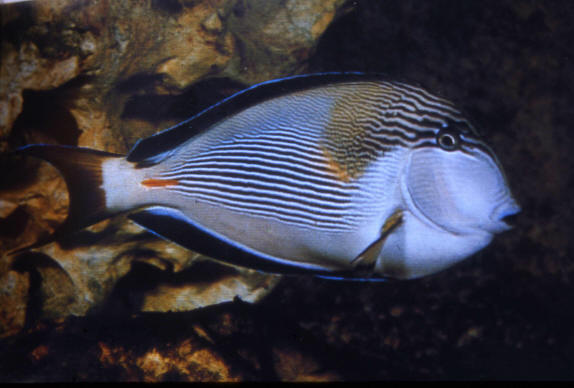
Surgeon fish Acanthurus
In the hot climate of the Emirates water sports are naturally popular.
Among the many water sports that can be enjoyed in the UAE, diving and
Snorkeling are practiced by many residents and visitors. Whereas deep water
diving demands some training, Snorkeling needs no skills and anyone who can
swim can enjoy this sport that gives access to the magic underwater world.
Several centres in Dubai, Sharjah and in the East Coast hotels give PADI courses
for divers and provide equipment for rent or for sale, while they also offer
guided tours to the best locations.
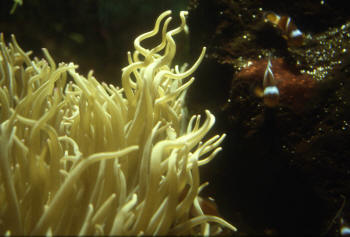 |
Clown fish and anemone |
In
the Arabian Gulf most of the diving is on old wrecks of barges and cargo vessels
as well as on the new artificial reefs that are being created along the Jebel
Ali coast in the emirate of Dubai. The wide shallow beaches of the Gulf do not
make for interesting Snorkeling.
On the Indian Ocean coast there are various great spots for diving as well as
Snorkeling. Good places are found on Shark Island in Khor Fakkan, Martini rock,
the beaches near Sharm (particularly good for looking at corals, best done at
night), Dibba rock and Lima rock further north. The most pristine sites are
along the rocky shorelines of Khor Hablein in the northern Musandam. The rocky
coast to the north of the Oceanic Hotel also provides good Snorkeling as well
as the coast just north of Dibba.
While most of these places have to be reached by boat, Snoopy rock can be
reached by swimming or even on foot from the beach at low tide. It lies just off
the coast in front of the Sandy Beach motel. It does not take long to swim
around the island, but once you don a mask and snorkel it can take hours before
you can tear yourself away from the underwater wonders.
On the west side of Snoopy rock the water is very shallow, and the ocean floor
is littered with rocks interspersed with sea cucumbers and sand dollars, a type
of flat sea-urchin. The southern side of the island has a large shallow area of
brain and boulder corals while the west and north sides are quite steep and
offer good views of rocky crevices and the deep water of the ocean. Close to the
island the fishes abound: the quick clownfish, playing hide and seek in the
fringes of sea anemones, small colourful wrasses and strange-shaped trunk
fishes.
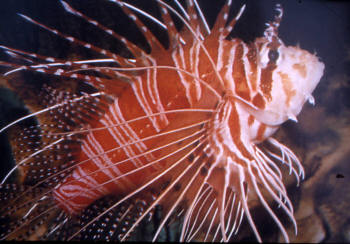 |
Lionfish Pterois volans |
In the shallow areas snorkellers can explore between the rocks to look for
shells. Of course, the shells on the seabed are often still occupied by the
gastropod that created them and to see a live one, half-covered with its mantle,
is a treat! The colours are much more vibrant than after the shell has washed
ashore. The moon snail (Natica alapapolionis) is a predator that drills holes in
the shells of other gastropods in order to get at the soft animal inside. The
shells of its victims can often be found washed up on the beach with a neat
round hole telling the tale of their demise. The moon snail leaves another sign
of its presence on the beaches: the sand collars. These amazing structures with
their often crenellated edges are in fact the egg cases of the moon shell made
by mixing mud and sand from the seabed with its sticky eggs. When you find them
in the tidal zone on the beach they feel rubbery and you can pick them up
without breaking them, after some time they dry out and become brittle. The only
way to preserve them is to spray them with hairspray.
Another gastropod that is common on the East coast is one of the cowries : the
beautiful Cypraea ocellata. There are bivalves too, venus clams and scallops.
Most are sessile but one species – a flame scallop called Lima fragilis can
propel itself for short distances by clapping its shells together.
On the rocks in the tidal zone one can find oysters, barnacles and chitons. All
these creatures seem welded to the rocks. This powerful attachment is needed in
order for them not to be dislodged by the wave action, since they usually occur
exactly at the surf line.
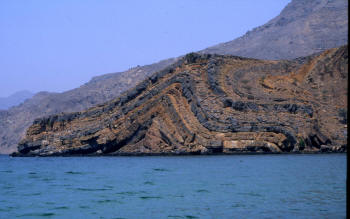 |
Khor Hablein |
One of the most amazing sights is that of a nudibranch undulating past. These
sea slugs have bizarre markings and flamboyant colours and move through the
water as if they are performing a slow motion ballet. Their bright colours serve
as a warning to would-be predators that they can give unpleasant stings. They
are able to do this because they feed on a variety of stinging invertebrates
such as hydroids and sea anemones and can store the stings (nematocysts) of
their prey in their own bodies. The most common sea slug is Chromodoris annulata – a white slug with circles outlined in purple and yellow spots. The frills on
its back are its exposed gills that give the family its name (nudibranch = naked
gill).
On the ocean side shoals of sardines, sergeant-majors (Abudefduf saxatilis) and
yellow-marked angelfish (Pomecanthus maculosus) float or dart past. The sardines
move in enormous groups that seem to form one huge body. This is a defence
strategy – safety in numbers. When a predator fish attacks the small fishes
disperse in all directions confusing it and therefore preventing it from making
a catch.
One of the larger fishes is the spectacular Surgeon fish (Acanthurus sp.), so
called because it has a very sharp thorn on both sides of the base of its tail
that can be retracted into a slit. When raised, these thorns are formidable
weapons in fight, when the fish whips its tail sideways and causes deep cuts
into the flanks of an opponent. They usually move in small shoals. Another
remarkable fish, one that swims singly, is the Picassofish (Rhinecanthus
aculeatus), easily recognisable by its boldly coloured pattern of stripes and
dots.
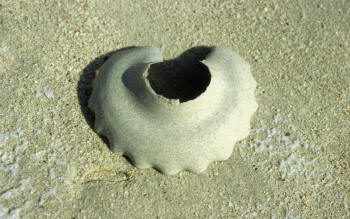 |
Sand Collar |
If you are lucky, you may be visited by a curious cuttlefish (Sepia sp.) as I
experienced once. The creature floated around me, displaying the most amazing
colours that moved back and forth over its body like fluid fluorescent paint.
After I saw it in all its glory, I was sorry to see a catch on the beach
spearfished by a human predator.
There is no need to be afraid of the white-tipped reef sharks or nurse sharks
that can be seen occasionally loafing on the seabed. They are friendly sharks – none of the dangerous ones are likely to disturb you in any of the East coast
Snorkeling locations. Hammerhead sharks do occur but stay in deep waters.
Another friendly large animal that can be encountered often is the Green turtle
(Chelonia mydas). They still nest on the beaches near Kalba although in much
fewer numbers than in the past.
In fact, the whole East coast is in need of protection, if it is to have a
future as a marine tourist attraction. There is a lot of shipping movement along
the coast and unfortunately illegal voiding of sludge and oil leaks are
frequent. Some marine nature reserves have been pronounced by the Fujeirah
authorities but not much is done to enforce the laws. Spearfishing has reduced
the biodiversity around, for instance, Snoopy rock, considerably and many of the
wonderful species that could be seen there only two decades ago have already
disappeared. The locations to the north, along the Musandam coast and Lima rock
are more pristine as yet. A very real threat to marine life are bad fishing
practices, such as anchoring on coral reefs, losing gargour fish traps that can
kill hundreds of fished over the years, and drift nets in which air-breathing
turtles, dolphins and even whales can be entangled and drowned.
Although Snorkeling holds few dangers there are a few ‘nasties’ that every
swimmer should be aware of. At Snoopy rock, for instance, you have to be careful
in places where there are rocks strewn on the bottom, for it is quite possible
that one of those weed-encrusted rocks is actually a stonefish. Throughout its
entire life the stonefish barely moves, depending on its camouflage to catch
unsuspecting passing fishes, and on its poisonous dorsal spine for its
protection. It is very dangerous to step on a stonefish, as both the poison and
the shock of the pain can be fatal. So the advice is not to put your foot down
on any rock, even with flippers on. Stonefish have been recorded at Dibba and
Khor Fakkan also.
Scorpion fish also occur. At first sight they are very similar to stonefish but
they differ in that they do move and their eyes are visible. Although also
poisonous they are not as harmful as the stonefish.
Another creature that is better avoided is the sea urchin (Echinometra mathaei
and Diadema spp) of which there are hundreds tucked between the rocks. The dark
brown spines are barbed and very difficult to remove, once embedded in a heel or
palm. Infections can occur after sea urchin spines are removed.
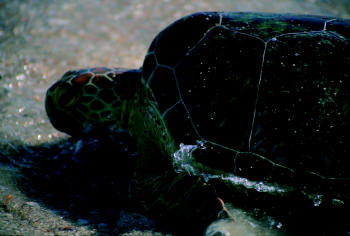 |
Green turtle |
Then there is the colourful lionfish (Pterois volans), with its white and
orange-red bands and multiple long spines. These spines are strongly poisonous
but because the fish moves, it is easier to avoid.
Last but not least there are the sea snakes with the Yellow-bellied seasnake (Pelamis
platurus) being the most common one found on both coasts. In general they are
not aggressive and their mouths are very small so it is not easy for them to
deliver a bite to a large victim, but their poison is very strong. It needs to
be strong because in water it becomes diluted and the snake depends on its
effectiveness for success in its hunts.
Stingrays (Taeniura melanospina) are more a feature of the Gulf waters, where
the coast is much less steep. These large flat fish come close into shore at the
change of the seasons (September-October and March-April). They lie partly
buried in the sand and if stepped upon, they whip their tail around which has a
large barbed spine at the base.
Usually the sting penetrates somewhere around
the ankles and the pain is said to be excruciating. However, the sting is not
poisonous and the pain subsides in 7 or 8 hours, during which time it can be
mitigated by holding the affected body part in very hot water. Afterwards a
course of antibiotics is advisable because the mucus that coats the sting can
contain many bacteria.
Shell collectors should be aware, when picking up cone shells (Conus spp.), to
always keep the narrow part of the shell away from the body. The animal
inhabiting the shell can shoot a harpoon-like hollow tooth that injects a
dangerous neurotoxin. In the interest of conserving nature, it is in any case
better to only collect those shells that no longer contain a live creature.
As long as you are aware of the few dangers in the sea, you Snorkeling trip can
be a truly wonderful experience that will leave you with great memories for the
rest of your life.
|